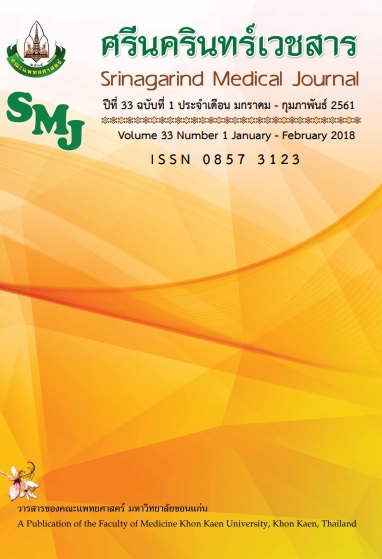The Effect of Rigid Tape and ElasticTape on Navicular Height and Gait in People with Flexible Flat Feet
Keywords:
Flexible flat feet; Rigid tape; Elastic tape; Gait parameter; ภาวะเท้าแบนแบบยืดหยุ่น ผ้าเทปชนิดไม่ยืดหยุ่น; ผ้าเทปชนิดยืดหยุ่น; ตัวแปรในการเดินAbstract
Background and Objective: Flexible Flat Feet is the loss of the medial longitudinal arch of the foot, which disturbs walking performances. One of the methods from physical therapy on people with flat foot conditions is a taping technique. The aims of this study were to compare the effects of Rigid tape and Elastic tape on Navicular drop test (NDT) and gait parameters in the participants with the flexible flat feet.
Methods: The design of this study was cross sectional study. At the screening process, participants were randomly separated into two groups for receiving either Rigid tape group (n=9) or Elastic tape group (n=9). All participants were received baseline and immediately assessments after tapping. Navicular drop test and gait parameters were tested by the dry foot print. Gait parameters were consisted of step angle and gait velocity.
Results: NDT in both groups at baseline were 11.2±0.7 for Elastic tape group and11.4±0.9 mm. for Rigid tape group, respectively. After tapping, NDT in both groups were 5.00±2.2 for Elastic tape group and 5.00±0.9 mm. for Rigid tape group, respectively. Significant differences were found within group of NDT(p = 0.001 and 0.001, respectively) but not significant difference on gait parameter. There were no significant differences between groups in either NDT or the gait parameters.
Conclusion: The effects of both Rigid tape and Elastic tape can improve the medial longitudinal arch of the foot, however it could not change the gait parameters.
ผลของเทปชนิดยืดหยุ่นและไม่ยืดหยุ่นต่อส่วนโค้งฝ่าเท้าด้านในและการเดินในอาสาสมัครที่มีเท้าแบน
พิมลพรรณ ทวีการ วรรณจักร*, คุณาวุฒิ วรรณจักร, กิตติชนม์ สมหวาน, อภิชาติ ปัญจพลานุรักษ์,
อติวิชญ์ จันทรังษี
สาขากายภาพบำบัด คณะสหเวชศาสตร์ มหาวิทยาลัยบูรพา
ส่งผลต่อความสามารถในการเดิน การพันผ้าเทปเป็นวิธีการรักษาทางกายภาพบำบัดอย่างหนึ่ง ดังนั้นการศึกษานี้จึงมีวัตถุประสงค์เพื่อเปรียบเทียบความแตกต่างของความสูงของส่วนโค้งใต้ฝ่าเท้าและความสามารถในการเดินของอาสาสมัครสุขภาพดีที่มีภาวะเท้าแบนแบบยืดหยุ่นที่ได้รับการพันผ้าเทปชนิดยืดหยุ่นและผ้าเทปชนิดไม่ยืดหยุ่น
วิธีการศึกษา: รูปแบบการศึกษาคือ cross sectional study อาสาสมัครได้รับการสุ่มแบ่งเป็นสองกลุ่มคือกลุ่มที่ได้รับการติดผ้าเทปชนิดยืดหยุ่นจำนวน 9 ราย และกลุ่มที่ได้รับการติดผ้าเทปชนิดไม่ยืดหยุ่นจำนวน 9 ราย อาสาสมัครได้รับการประเมิน Navicular drop test (NDT) และการประเมินค่าความแตกต่างของตัวแปรในการเดินด้วยวิธีการพิมพ์รอยเท้าแบบแห้ง
ผลการศึกษา: ค่าความสูงของส่วนโค้งใต้ผ่าเท้าก่อนการได้รับการพันผ้าเทปชนิดยืดหยุ่นและไม่ยืดหยุ่นคือ 11.2±0.7 และ 11.4 ± 0.9 มิลลิเมตร ตามลำดับ ส่วนภายหลังการพันเทปค่าความสูงของส่วนโค้งใต้ผ่าเท้าคือ5.0±2.2 และ 5.0 ± 0.9 มิลลิเมตร ตามลำดับ พบว่าค่าความแตกต่างของ NDT ภายในกลุ่มมีความแตกต่างอย่างมีนัยสำคัญทางสถิติ (p = 0.001, 0.001 ตามลำดับ) ส่วนระหว่างกลุ่มค่า NDTไม่มีความแตกต่างกันอย่างมีนัยสำคัญทางสถิติ ค่าความแตกต่างของตัวแปรในการเดินทั้งภายในกลุ่มและระหว่างกลุ่มอาสาสมัครไม่มีความแตกต่างกันอย่างมีนัยสำคัญทางสถิติ
สรุป: การพันผ้าเทปชนิดยืดหยุ่นและการพันผ้าเทปชนิดไม่ยืดหยุ่นสามารถปรับปรุงความสูงของส่วนโค้งใต้ฝ่าเท้าได้ แต่ไม่สามารถเปลี่ยนแปลงรูปแบบในการเดินได้




